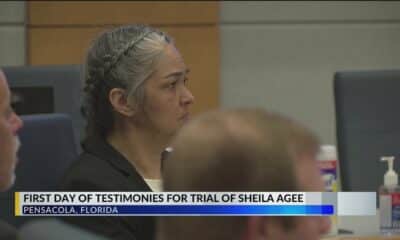News from the South - North Carolina News Feed
George Dixon, renowned blacksmith; Michael and Nora Drye, and their grandson, Micah • Asheville Watchdog
Asheville Watchdog is bringing you the stories behind the staggering loss of life from Helene, the children, parents, grandparents, multiple generations of a single family, all gone in one of the worst natural disasters to hit the mountains of western North Carolina. This is the sixth installment.
Jill Dixon hunkered in her husband’s office in their Swannanoa home, clinging to their two dogs, as the water from the Bee Tree Creek breached its banks and rapidly rose toward the house and then inside.
“The water came up higher and higher and higher, and I was yelling for help,” she said. “The water was up to almost my shoulder…and George didn’t answer.”
George Dixon, 72, had gone into a bedroom in the back of the house to retrieve car keys and evacuate his family. Torrential rains from Tropical Storm Helene Sept. 27 had turned the creek into raging floodwaters.
Read previous installments of The Lives We Lost.
In a matter of minutes, the water had ripped the back of the Dixons’ home off its foundation, sweeping away a back bedroom with George Dixon in it.
“Somehow, I don’t know how, he made it around to the front and was hanging on to a tree in the front yard and then another big gush of water came really deep, very forceful,” Jill Dixon said. “Trees were falling everywhere, and he got swept away again, and that was the last time I saw my husband.”
With the water inside the house several feet deep, Jill Dixon, 69, climbed onto a dresser with her dogs. Her 40-year-old daughter and two grandsons, 19 and 17, one of whom is autistic and uses a wheelchair, floated on a mattress, she said.
“I was trapped in there, probably for five or six hours, and I was having hypothermia, shaking, chills, blue lips, blue nail beds,” she said. “The water was getting deep, so we kicked out the window to get some of the water out … and it was really scary.”
A neighbor finally reached them, traversing washed out roads and bridges. ”There were so many trees down that the neighbor had to use a chainsaw and cut a tunnel through the trees to get me out,” Jill Dixon said.
Her husband’s body was found two days after the storm, buried in mud, but Jill Dixon said he was not positively identified until Oct. 13, two weeks later. “I was so worried and so upset,” she said. “I kept wondering where he was.”
Highest honor in blacksmithing
Dixon was a renowned blacksmith described by fellow artists as among the best in the country.
“He did everything from big chandeliers, iron gates, the old way blacksmiths did it,” his wife said. “Everything was handmade, hand sanded, very detailed, and he had the most complete blacksmith shop in the United States.”
Dixon had been head blacksmith at Samuel Yellin Metalworkers in Philadelphia before moving to Swannanoa in 1992. He helped restore the decorative iron and metal works of Yellin, the country’s premier 20th century blacksmith, whose pieces from the early 1900s included commissions for the Federal Reserve Bank of New York, Yale and Princeton universities, and the Washington National Cathedral.

Dixon taught Yellin’s techniques at demonstrations throughout the country and was founder and editor of “the Traditional Metalsmith” and later “The Artist-Blacksmith,” quarterly publications dedicated to traditional methods of fine architectural ironwork.
Dixon received the 2019 Alex Bealer award, the highest honor from the Artist-Blacksmith Association of North America “for contributions to the blacksmith world,” said Leigh Morrell, the group’s former president.
He chaired the association’s best attended national conference, held in Asheville in 1998, that attracted blacksmiths from around the world, Morrell said.
“The guy was incredible,” said Morrell, who along with Dixon started the Historic Blacksmith Conservancy.
Dixon specialized in Gothic work, said Ernie Dorrill, a blacksmith and friend in Canton, Miss.
“Some of it was very small work, very tiny, like rivets, and some was rather large, like gates,” Dorrill said. “He did a lot of restoration of Yellin’s work,” including two lanterns at the Bank of Philadelphia, each weighing two tons.

Dixon’s love for blacksmithing began as a hobby, and he largely taught himself.
“George researched everything,” Dorrill said. “He said, ‘Look Ernie, these are the same tools they used 1,000 years ago, and if you want to do good hand work, you’ve got to use the same techniques and technology.’
“He was brilliant, he really was,” Dorrill said “We’ve had a tremendous loss with George… It ripped a hole in my heart.”
Dixon had a shop in his house and was still working.
“It’s a real hard craft to learn, and it takes a long time,” his wife said. “But he was a very special guy, and that was pretty much his hobby, too, blacksmithing, that’s what he did. His whole life centered around that.”
Dixon was writing his third book, Jill Dixon said.
“We help each other out”
A blacksmith friend and Dixon’s son are hoping to salvage his work from a computer that was damaged in the floodwaters, Dorrill said. They’ve also been sifting through mud to recover Dixon’s tools and drying water-soaked drawings.
“He was a superb illustrator,” Dorrill said.
Jill Dixon said she’s grateful to the support of her husband’s blacksmith community and her neighbors along Bee Tree Road.
After she was rescued, Dixon said one neighbor “was nice enough to give me some dry clothes and a place to sleep overnight and some food.”
“It’s been truly an outpouring of caring for each other that’s part of the community up there,” she said. “We help each other out. It’s a lot of Christian people around you, the Bible Belt area.”
Dixon said her pastor took her in for several nights. Their church, Bee Tree Christian Church, founded in 1872, was also severely damaged in the storm.

Dixon said she went two days without water.
“I have to give myself heart medicine, and I have to, every week, give myself a shot because of rheumatoid arthritis,” she said. “I went without any medicine for over three weeks. I could hardly walk by that time.”
Dixon was stunned when she saw the widespread devastation from Helene.
“It was so traumatic for me to see whole neighborhoods swept away – holes, massive, deep holes in the ground, trees down everywhere. People were desperate for food, water, clothing,” she said.
She’s leaning on her faith to cope with her enormous loss.
“I thank the good Lord that I lived through it, because I could have drowned very easily,” Dixon said. “I was rescued, and my faith in God has gotten so much stronger since this experience.”
She salvaged two photos from the ruins of her home, the only ones she has left, including one of her and George. On Oct. 7, they would have been married 50 years.

Dixon is now staying with a friend in Raleigh.
“I’m trying to start over, but it’s been really difficult,” she said. “I lost my husband, I lost my car, everything … all my cards, my purse, all my records, documents that you have, everything, my antique furniture. I had a good Chinese collection of really old pieces.”
Dixon does not intend to return to the Asheville area. “I don’t want to ever go through something like that again,” she said.
The couple’s two dogs, Rally, a Pomeranian, and Loki, a mountain feist, survived the flood, but Dixon said she could no longer keep them.
“They went to an animal shelter,” she said. “They’ve been put up for adoption. It’s sad. I miss them, too, but … I’m accepting the realities I have right now.”
She said she has not yet received assistance from FEMA. A GoFundMe page to benefit her had raised nearly $18,000 as of Saturday.
Dixon said she’s keeping a positive attitude.
“I think each day will get a little bit better,” she said. “I get a second chance at life.”
Michael, Nora and Micah Drye
The deaths of Michael and Nora Drye, both 73, and their 7-year-old grandson, Micah, and the rescue of their daughter Megan Drye, 39, were broadcast almost in real time on Facebook. There, their daughter, Jessica Drye Turner, pleaded for prayers.
“My family is currently on the roof of their house in Asheville, NC with nothing but the clothes on their back and one working phone,” Turner wrote at 1:46 p.m Sept. 27. A little over half an hour later, she posted a photo of someone’s feet perched on a roof. Brown floodwaters were lapping at the eaves of the Dryes’ Swannanoa River Road home.

At 4:23 p.m., she updated the post with another photo. It was one of the last images of Nora Drye. She was looking out at the destruction.
Eighteen-wheelers and cars were floating by, the group of four reported via their one phone.
At 2:54 a.m. Sept. 28, Turner provided a horrifying update.
“[M]y parents and nephew drowned bc the roof collapsed,” she posted. “My sister got wedged btw something. She was rescued an hour later.”
Leaning on her faith, Turner typed out a mournful celebration of her parents’ life and a plea for Megan’s.
“The image I focus on every time I imagine that moment is how joyfully they are praising Jesus at his feet, dancing with renewed bodies and not remembering how they passed,” she wrote. “I plead to Jesus to hold my sister tightly. God is faithful. Just. Weeps and mourns when we do and comforts us in our times of need. He rescued my parents and nephew in his way and took them home.”
Nearly 12 hours later, Turner reported she had located Megan. Someone called a local hospital, connected with a nurse who brought the phone to Megan, allowing her to speak with her family.
On Sept. 29, Jessica and her sister drove to Asheville and picked up Megan.
Nora Drye’s body was found nearly two miles from Micah’s and Michael’s in Biltmore Village, according to death certificates. Micah’s body was found Sept. 30, Michael’s on Oct 1, and Nora’s on Oct. 5.
The cause of Michael’s death was listed as a “landslide injury.” Micah and Nora’s cause of death was drowning, according to the death certificates.
Turner would return to the same Facebook post, updating it more than 20 times through Oct. 10, returning with more details about exactly what happened to her parents and nephew as recalled by Megan.
“The roof did not collapse, the house did,” Turner wrote in an Oct. 1 update, describing the ensuing panic and terror as the floodwaters took her family, one by one, sparing only Megan, who let herself float away and became lodged between two trailers before someone saw her.
Megan and Jessica told their stories to numerous news outlets, launching the story to international attention. Asheville Watchdog reached out to the family but was not able to connect for an interview.
Michael was an attorney and mediator for over 40 years, according to a joint obituary for the couple and their grandson. He “left a legacy of compassion and care in helping clients, friends, and family navigate the legal complexities of some of the most difficult seasons of their lives.”

In May 17 he was honored by the North Carolina State Bar for being a board certified family law specialist continuously for 30 years, according to his LinkedIn profile.
Nora was “a lover of life and devoted mother of three girls. [She] inspired many by being an unwavering example of living an active, pure, peaceable, and quiet life,” the obituary said.
The two were members and leaders at Biltmore Church, according to a report from Religious News Service.
“Micah will be remembered for his vibrant energy, his gentle and affectionate spirit, and his relentless pursuit to become a superhero, which he did,” the obituary said.
A memorial service for the three is set for Monday at Biltmore Baptist Church.
– Andrew R. Jones, Asheville Watchdog
Asheville Watchdog is a nonprofit news team producing stories that matter to Asheville and Buncombe County. Sally Kestin is a Pulitzer Prize-winning investigative reporter. Email skestin@avlwatchdog.org. Andrew R. Jones is a Watchdog investigative reporter. Email arjones@avlwatchdog.org. The Watchdog’s local reporting during this crisis is made possible by donations from the community. To show your support for this vital public service go to avlwatchdog.org/support-our-publication/.
Related
The post George Dixon, renowned blacksmith; Michael and Nora Drye, and their grandson, Micah • Asheville Watchdog appeared first on avlwatchdog.org
News from the South - North Carolina News Feed
Two women killed and several children hurt in Johnston County crash
SUMMARY: Two women in their 20s died in a car crash in Johnson County, with six children aged under 12 also in the vehicle; one child is in critical condition. The single-car accident occurred at the intersection of Government and Jack roads in Clayton. Investigators report that the driver, speeding about 30 mph over the limit and running a stop sign, lost control, hitting a ditch and a tree before the Jeep Cherokee went airborne. None of the occupants were wearing seat belts, and while alcohol isn’t suspected, the area has a history of crashes.
Two women were killed and several children were hospitalized after an SUV crashed Saturday night in Johnston County.
News from the South - North Carolina News Feed
5 On Your Side Restaurant ratings: Pure Vegan Cafe, Randy's Pizza and Chanello's Pizza
SUMMARY: Inspectors identified food handling and storage issues at several local restaurants. Pure Vegan Cafe in Durham received an 82, down from 91.5, for improper food storage, unclean equipment, and incorrect expiration dates. Randy’s Pizza in Morrisville was rated 86 (down from 94.5) due to employees failing to wash hands after handling personal items, inadequate food temperatures, and fly infestations. Chanello’s Pizza in Garner scored 88.5 (down from 91) after inspectors found expired ingredients, unclean baking trays, and a sticky fly ribbon above the prep sink. Overall, health standards were not adequately maintained across these establishments.
5 On Your Side’s Keely Arthur shows us the problems in this week’s restaurant ratings report.
News from the South - North Carolina News Feed
Man sentenced in 2018 murder of 13-year-old Hania Aguilar tries twice to escape
SUMMARY: Robinson County Sheriff Bernes Wilkins reported heightened security during prisoner Michael McLen’s court hearing. McLen, who pled guilty to the kidnapping and murder of 13-year-old Hana Aguilar and was sentenced to life in prison, made two escape attempts. He first tried using a homemade handcuff key but was stopped by deputies. Returning to prison, McLen grabbed a deputy’s gun during a struggle before being subdued with pepper spray. Eyewitnesses noted his courtroom demeanor seemed insincere, raising questions about potential additional charges from the escape attempts.
Michael Ray McLellan admitted to kidnapping 13-year-old Hania Aguilar from her driveway and then killing her and disposing of her body. The crime happened in November 2018. On Friday, November 22, 2024, he was sentenced to life in prison without the possibility of parole. Investigators say McLellan tried twice to escape from his prison guards — before and after the hearing.
https://abc11.com/post/hania-aguilar-michael-mclellan-guilty-nc-kidnapping-murder-13-year-old-girl-lumberton/15573797/
https://abc11.com/watch/live/11065013/
Download: https://abc11.com/apps/
Like us on Facebook: https://www.facebook.com/ABC11/
Threads: https://www.threads.net/@abc11_wtvd
Instagram: https://www.instagram.com/abc11_wtvd/
TIKTOK: https://www.tiktok.com/@abc11_eyewitnessnews
-

 Kaiser Health News6 days ago
Kaiser Health News6 days agoA Closely Watched Trial Over Idaho’s Near-Total Abortion Ban Continues Tuesday
-

 Local News5 days ago
Local News5 days agoSherral’s Diner to be featured on America’s Best Restaurants
-

 News from the South - Georgia News Feed4 days ago
News from the South - Georgia News Feed4 days agoJose Ibarra found guilty in murder of Laken Riley | FOX 5 News
-

 News from the South - Alabama News Feed5 days ago
News from the South - Alabama News Feed5 days agoTrial underway for Sheila Agee, the mother accused in deadly Home Depot shooting
-

 News from the South - Kentucky News Feed4 days ago
News from the South - Kentucky News Feed4 days agoNicholasville organization activates weather plan in response to bitter cold temperatures
-

 News from the South - Alabama News Feed3 days ago
News from the South - Alabama News Feed3 days agoJudge grants mistrial in Sheila Agee trial due to ‘unhinged juror’
-

 Local News2 days ago
Local News2 days agoIntroducing our Student Athlete of the Week: Ocean Springs’ very own Mackenzie Smith
-

 News from the South - Alabama News Feed4 days ago
News from the South - Alabama News Feed4 days agoAlabama's weather forecast is getting colder, and a widespread frost and freeze is likely by the …























